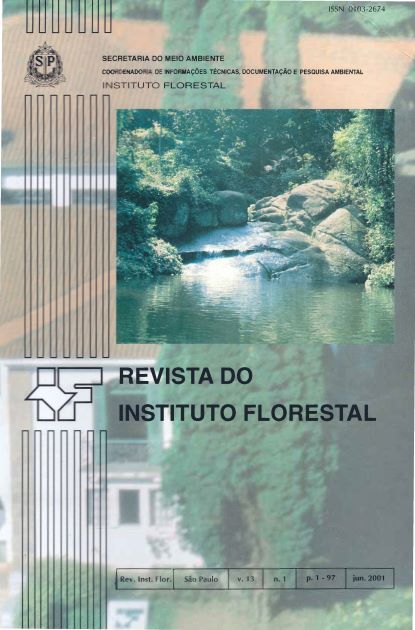SISTEMA DE REPRODUÇÃO EM POPULAÇÕES DE Esenbeckia leiocarpa Engl.
DOI:
https://doi.org/10.24278/2178-5031.2001131626Keywords:
mating system, Esenbeckia leiocarpa, electrophoresis isozymes, population genetics, forest fragmentationAbstract
The mating system of two natural populations of Esenbeckia leiocarpa (guarantã) was studied in two forests fragments in São Paulo State, by isoenzymes. The mating system showed that the species 1s alogamous, but the homogeneity of pollen and ovules ,..alelle frequencies and the patemity correlation ( r P ) showed that outcrossing m natural populations of E. leiocarpa was not random, generating a small number of individuais by outcrossing among relatives and preferentials. The sefing correlation ( r ) demonstrated that selffertilization individuais are found randomly distributed wjthin progenies and the patemity correlation ( r ) indicated the existence of high proportions bf full-sibs within outcrossing progenies. ln comparing the mating system parameters between fragments, differences were not observed between the larger (Caetetus) and smaller (Ibicatu) fragments.
Downloads
References
ALFENAS, S. A. Eletroforese de isoenzimas e proteínas afins: fundamentos e aplicações em plantas e microrganismos. Viçosa: UFV, 1998. 574 p.
ALLARD, R. W. Princípios do melhoramento genético das plantas. São Paulo: Edgard Blucher, 1971. 381 p.
CLAYTON, J.; TRETfAK, D. Amine-citrate buffers for pH control in starch gel elcctrophoresis. Journal Fisheries Research Board Canadian, Canada, v. 29, p. 1 169-72, 1972.
CRESTANA, C. S. M.; DIAS. I. S.; KAGEY AMA, P. Y. Biologia floral do guarantã (faenbeckia leiocarpa Engl.). ln: CONGRESSO FLORESTAL BRASILEIRO, 4., 1982, Belo Horizonte. Anais... São Paulo: SBS, 1 982. (Silvicultura, São Paulo, v. 28, p. 35-38, 1982).
ELLSTRAND, N. C. ; ELLAN, D. R. Population genetic consequences of small population sizcs: implication for plant conservation. Annual Review on Ecological Systematics, Davis, v. 24, p. 2 17-242, 1 993.
HAMRICK, J. L. Isozymcs and analysis of genetic structurc in plant populations. ln: SOLTIS, D. E.; SOLTIS, P. (Ed.). Isozymes and the analysis of genetic structure in plant populations. London: Chapman and Hall Ltd., 1 989. p. 87-105.
____ .; GODT, M. J. W. Allozymc diversity 111 plant spec1es. ln: BROWN, A. H. D. et oi. (Ed.). Plant population genetics, breeding and genetic resources. Massachusetts: Sinauer, Sunderland, 1989. p. 43-63.
HAMRICK, J. L.; LOVELESS, M. D. The influence of seed dispersai mechanisms on the genetic structure of plant populations. ln: ESTRADA, A.; FLEMING, T. H. (Ed.). Frugivores and seed dispersai. New York: Junk Publishers, 1 986. cap. 17. 392 p.
____ .; SCHNABEL, A. Understanding the genetic structure of plant populations: some old problems and a new approach. ln: GREGORIOUS, H. R. (Ed.). Lecture notes in biomathematic; population genetics in forestry. Berlin: Springer Verlag, 1 985. p. 50-70.
KEPHART, S. R. Starch gel electrophoresis of plant isozymes: a comparative analysis of techniques. A merican Journal of Botany, Oklahoma, v. 77, n. 5, p. 693-7 12, 1990.
LEWIS, P. O.; ZAYKIN, D. Genetic date analysis. Versão 1. O para Windows 3 .1. 1999. (Não publicado).
RITLAND, K. Series of FORTRAN computer programs for estimating plant mating systems. Journal ofHeredity, Cary, v. 8 1, p. 235-237, 1990. Multilocus mating system program ML TR: version 1.1. Canada: University of Toronto, 1 997. (Não publicado) .
______. ; EL-KASSABY, Y. A. The nature of inbreeding in a seed orchard of Douglas-Fir as shown by an efficient multilocus model. Theoretical Applied Genetics, Berlin, v. 71, p. 375-384, 1985 .
______ ; JAIN, S. A model for the estimation of outcrossing rate and gene frequencies using independent loci. Heredity, Lund, v. 47, p. 35-52, 1981.
SHAW, D. V.; ALLARD, R. W. Estimation of outcrossing rates in Douglas-Fir using isozyme markers. Theoretical Applied Genetics, Berlin, V. 62, p. 1 13-120, 1982.
SQUILLACE, A. E. Average genetic correlations among offspring from open-pollinated forest trees. Silvae Genetica, Frankfurt, v. 23, p. 149-156, 1974.
SURLES, S. E. et ai. Genetic relatedness in open pollinated families of two leguminous tree species, Robinia pseudoacacia L. and Gleditsia triacanthos L. Theoretical Applied Genetics, Berlin, v. 80, p. 49-56, 1990.
SWOFFORD, D. L.; SELANDER, R. B. BIOSYS-1. A FORTRAN computer program for the analysis of allelic variation in population genetics and biochemical systematics. Journal of Heredity, Cary, v. 72, p. 282-283, 1989.
WORKMAN, P.; NISWANDER, J.L. Population studies on southwestem Indian tribes. II. Local genetic differentiation in the Papago. American Journal Human Genetic, Chicago, v. 22, p. 24-49, 1970.
WRIGHT, S. Isolation by distance. Genetics, Washington, v. 28, p. 1 14-138, 1943. The interpretation of population structure by F-statistics with special regard to systems of mating. Evolution, San Francisco, V. 19, p. 395-420, 1 965 .
YOUNG, A. ; BOYLE, T.; BROWN, A. H. D. The population genetic consequences of habitat fragmentation for plants. Tree, Victoria, v.11, n.10, p. 413-418, 1996.















